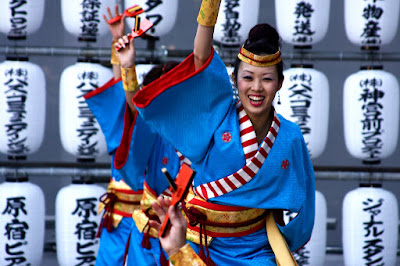Known as matsuri (祭) in Japanese, these celebrations have their roots in Chinese festivals from centuries ago. Most matsuri are Shinto in origin with a connection to a local shrine where the gods or spirits known as kami reside. A festival is a time for breaking out the sake, enjoying wild dancing and singing, and getting closer to the gods. It is the only time of the year when the deities can leave the sanctuary of the shrine to be out amongst the people in the streets.
Festivals typically celebrate the shrine’s deity or a historic event. Portable shrines called mikoshi house the kami when they are brought out from the shrine and paraded for the festival in front of thousands of adoring fans.
The best way to fully immerse yourself in the matsuri experience is to wear a yukata (a light summer cotton kimono) and geta (wooden shoes).
Here are a few of the many must see summer festivals to add to your Japan itinerary.
Aomori Nebuta Matsuri in the northern Tohoku region of Japan. This spectacular summer festival features colorful lantern floats called nebuta which are paraded through the streets of central Aomori every August. The enormous floats are constructed of painted washi paper by local teams and often depict historical figures, famous Japanese samurai, kabuki actors, or mythical creatures.
 |
| Photo Credit: Yo3up at Flickr |
Gion Matsuri in the ancient capital of Kyoto. This summer festival dates back to 869 and is held over the entire month of July. It is the festival of Yasaka Shrine and was originally held to appease the gods after an outbreak of disease. The highlight is the famous grand procession of elaborately decorated festival floats which occurs on July 17th.
 |
| Photo Credit: Patrick Vierthaler at Flickr |
Gujo Odori in the picturesque riverside town of Gujo Hachiman in the mountains of Gifu Prefecture in central Japan. This summer street dance festival is one of the three most important traditional bon dance festivals in Japan. The festival started over 400 years ago in an attempt by the local feudal lord to bring all the people of his domain together regardless of rank or social position in order to enjoy one massive street party.
 |
| Yosakoi Festival by Kumar nav at Flickr |
Sendai Tanabata Matsuri in Miyagi Prefecture. Held in downtown Sendai from August 6th to 8th, it celebrates Tanabata (The Star Festival). Tanabata originates from Chinese folklore and is based on the romantic legend of Hikoboshi and Orihime, two star-crossed lovers separated by the Milky Way. The festival is famous for its thousands of brightly colored tanabata streamers that decorate the city.
 |
| Photo Credit: Yo3up at Flickr |
Sumidagawa Fireworks Festival in Tokyo. Fireworks have been a summer tradition in Japan for centuries. One of the biggest and best is this one along the banks of the Sumida River near Asakusa. It is the oldest fireworks festival in Japan and is held on the last Saturday of July. It is the perfect chance to try some street food with yatai (stalls) selling all kinds of delicious festival food and seasonal snacks such as takoyaki, yakisoba, shaved ice, and chocolate coated bananas.
 |
| Photo Credit: Wikimedia Commons |
























.png)








